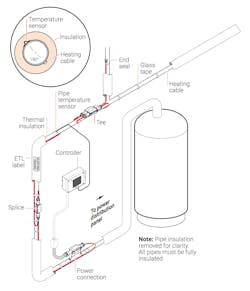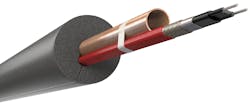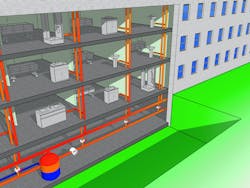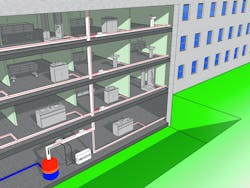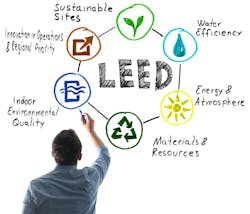Electric Heat Tracing Offers Hot Water Reliability
From post-gym showers to restaurant dish-washing stations, every day millions of people turn on faucets in commercial buildings expecting to receive hot water. For most, the immediate availability of warm water is a simple fact of life.
In reality, however, the task of maintaining the temperature of hot water is a complex and costly process, accounting for 7% of all energy used for commercial purposes.1 In addition, long stretches of piping between heat sources and supply fixtures result in 10-15% of hot water energy being lost in transit, while thousands of gallons of cool water are wasted waiting for taps to run hot.2 As the global climate crisis becomes an ever more pressing concern, the need to implement hot water distribution systems (HWDS) that can optimize water and energy usage has never been greater.
Two common methods for conserving energy and water are hot water recirculation and electric heat-tracing (EHT) systems. Both options offer significant improvements in wait times for hot water at points of use, but in many applications, EHT systems offer distinct benefits compared with more traditional recirculation. This article will discuss the advantages of these self-regulating systems, from helping to control the growth of harmful Legionella bacteria, to allowing building owners and designers to reduce energy consumption and earn valuable Leadership in Energy and Environmental Design (LEED) credits.
Getting into Hot Water
At the most basic level, hot water distribution systems consist of three main elements: a hot water source, such as a boiler; a piping network; and plumbing fixtures and appliances attached to the water supply at points throughout a building. However, as commercial buildings have become more architecturally complex over the past decade, so too have their internal infrastructures. Large numbers of varied fixtures serviced by multiple heat sources and extensive distribution piping are often required, increasing the risk of pipe heat loss and long wait times for hot water at points of use. Recirculation piping and EHT systems are technologies typically used to combat such wastage.In recirculating systems, additional piping and a series of pumps and valves are used to circulate hot water from boilers to usage points and back again. This method ensures that heated water reaches fixtures more quickly and loses less heat, as water is returned to the heat source and recirculated before being allowed to cool completely.
In contrast, EHT systems employ a one-way piping configuration, using specialized digitally controlled self-regulating heat tracing cables to apply heat along the pipe length and maintain water temperatures. Like recirculation, EHT systems reduce energy and water waste by improving wait times for hot water at fixtures. However, because with this method the heating cable can be applied directly to the output riser, hot water can be made available almost instantly provided there is enough water in the branch piping.
Making the Grade
With hot water being such a vital and energy intensive process, distribution systems in commercial buildings are subject to a host of state and federal standards. The 2007 Plumbing Systems & Design Report for example sets out requirements for hot water delivery based on a combination of pipe lengths, diameters and fixture flow rates. The report recommends that hot water should arrive at fixtures within 1 to 10 seconds to comply with best practice.
More seriously, since 2015 US buildings have been subject to the International Energy Conservation Code (IECC5), which in section C404.5.1. provides guidance on the maximum pipe lengths and the corresponding acceptable volume of water that should be present in the pipe work. Allowable flow rates for public lavatory faucets, for instance, are set at 2 ounces (0.06 liters), while for other plumbing fixtures or appliances 0.5 gallons (1.89 liters) is the maximum acceptable volume. Standards like these pose an additional challenge for building designers, as they require the installation of an HWDS that can provide hot water within the minimum time required, while also adhering to rules relating to maximum pipe length and water volume.
An additional factor that should be considered when designing a hot water distribution system is controlling the growth of potentially deadly Legionella bacteria (the bacterium most responsible for causing Legionnaires disease). To combat the risks associated with Legionella, The American Society of Heating, Refrigeration and Air-Conditioning Engineers (ASHRAE) and the 2018 International Plumbing Code (IPC) have developed a series of standards which architects and plumbing engineers must refer to when designing a building’s water systems.3
Improving on Recirculation
With building designs and environmental regulations becoming ever more complicated, the EHT method for hot water distribution presents a significant advantage over recirculation. In these systems, water temperature is maintained through the application of a specialized cable with a semi-conductive polymer core. This produces heat as the pipe cools down, and lowers its temperature as the pipe’s temperature rises, thus reducing the risk of wasting energy heating an already warm pipe.
These cables are flat, flexible and can be cut to length on site making them quick and easy to install effective temperature maintenance all the way up to the distal point. The one-way configuration allowed by these cables often makes EHT systems easier to design, since they do not require the extra piping, pumps, valves and sensors needed in recirculation networks. This reduction in hardware and design complexity means that heat tracing offers lower total installed costs (TOC) than recirculation, while also freeing up valuable floorspace within buildings, as multiple mechanical control rooms are no longer needed.
Adopting the EHT method can equally make compliance with various building codes and standards much simpler. Because these systems offer virtually non-existent wait times for hot water at points of use, the dilemma of achieving acceptable delivery time versus installing IECC5 compliant pipe lengths and volumes is overcome.
Combating Legionella
An area of compliance in which EHT systems potentially present an improvement is Legionella growth control. Research into the behavior of this bacteria has shown it to thrive in water between 77°F and 98.6°F (25°C and 37°C) but as temperatures increase to 107.6°F (42°C) and beyond, Legionella growth significantly declines and eventually ceases all together.4 Advice from the Special Pathogens Laboratory (SPL) therefore recommends that hot water systems are maintained at 131°F (55°C) or above to control Legionella growth, with engineering controls applied to distal points to avoid the risk of scalding.5
In traditional recirculation systems, maintaining a consistent, high temperature can be challenging, as water from the boiler can often be left to cool in branch-outs around distal points and in stagnant storage areas, separate from the hot water in the main delivery and return piping. The meeting of water from fixture feed pipes and the main system can also lead to convection mixing within the system, which studies have shown provides Legionella with both the ideal temperature for growth and a constant supply of nutrients.6
In contrast, EHT systems’ ability to apply heat right up to the point of use and maintain a consistent temperature profile throughout an entire system suggests this method can be considerably effective in managing Legionella growth. With the option to program multiple temperature zones and run intermittent temperature increases to ‘flush’ pipes, heat tracing appears to be a useful contribution to pathogen control technology – a solution which the SPL recommends should be considered in addition to recirculation.7
Reducing Waste
The primary purpose of recirculating and heat tracing systems is to reduce waste, and compared with no effort at all, both methods offer a vast reduction in water and energy consumption. Here, however, EHT systems seem to have the edge, offering both demand-adaptive programming and the ability to deliver hot water to fixtures quickly. Such systems can also be integrated into Building Management Software (BMS) to provide constant monitoring and predictive maintenance, improving the building’s efficiency and helping to avoid faults.
Thanks to these advantages over recirculating systems, only self-regulating EHT temperature maintenance networks are eligible to earn LEED credits. The LEED system is used globally to assess and improve the sustainability of buildings and provide an impartial points system to score various aspects of construction.
Buildings can be assessed on a range of criteria, with more points leading to a higher overall classification. The program has undergone several updates and currently operates on version four, which recognizes Alternate Compliance Path (ACP) methods in some categories and allows Standard Pilot Credits (SPC), each equivalent to one standard LEED credit to be earned in the category of Innovation in Design. Self-regulating EHT hot water distribution systems are eligible for both a Pilot Alternate Compliance Path Credit (pACP) as well as one point in the Innovation in Design category, thereby allowing buildings to earn extra LEED credits towards their final certification.
Addition or replacement?
There are many benefits when it comes to utilizing electric heat tracing in hot water distribution systems, but these are by no means an indication that recirculation has become obsolete. Further peer-reviewed research into the effectiveness of EHT systems in controlling Legionella growth is arguably needed, while many regulatory bodies are only now beginning to seriously assess heat tracing with a view to updating current recommendations. It seems clear, however, that heat tracing technology presents a significant opportunity for commercial building owners to reduce energy and water usage, while ensuring the people using these systems won’t have to endure the frustration of a tap that just won’t run hot.
_____________________________________________
Based in Rancho Cucamonga CA with more than 30 years of industry experience, author Bob Silva is now marketing manager for nVent Thermal Management, a division of nVent Electric plc., London UK.
1. U.S. Energy Information Administration, 2012 Commercial Buildings Energy Consumption Survey: Energy Usage Summary, March 2016, Fig. 5. https://www.eia.gov/consumption/commercial/reports/2012/energyusage.
2. Pacific Gas and Electric Company (PG&E) Applied Technology Services (ATS), Energy Performance of Forced Recirculation vs. HWAT in Commercial Service Water Heating Applications, 2015.
3. e.g. ANSI/ASHRAE Standard 188: Legionellosis: Risk Management for Building Water Systems (ASHRAE, 2000, 2018)
4. Wadowsky, R. M., Wolford, R., McNamara, A., & Yee, R. B., Effect of temperature, pH, and oxygen level on the multiplication of naturally occurring Legionella pneumophila in potable water, 1985, Appl. Environ. Microbiol., 49(5), 1197-1205.
5. Cloutman-Green, E., Barbosa, V. L., Jimenez, D., Wong, D., Dunn, H., Needham, B., Hartley, J. C., American journal of infection control, Controlling Legionella pneumophila in water systems at reduced hot water temperatures with copper and silver ionization, 2019.
6. Rhoads, W. J., Pruden, A., & Edwards, M. A., Pathogens, Convective Mixing in Distal Pipes Exacerbates Legionella pneumophila Growth in Hot Water Plumbing, 2016, 5(1), 29. doi:10.3390/pathogens5010029
7. NB: Further peer-reviewed study is needed to definitively assess the superior performance of EHT in controlling Legionella growth, but current information suggests such systems should be seriously considered when choosing a hot water temperature maintenance system

